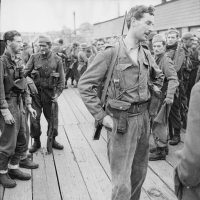Category: Books
-
![Destructive & Formidable by David Blackmore [Book Review]](https://www.cold-steel.org/wp-content/uploads/2018/12/dsc_0068.jpg)
Destructive & Formidable by David Blackmore [Book Review]
Destructive and Formidable by David Blackmore is a quantitative look at British infantry doctrine using period sources from the British Civil Wars of the seventeenth century up to just before the Napoleonic wars. If anything you can see the constancy, which drove the success in battle of British forces, even when outnumbered. Development of British…
-
Leading Gurkhas – A Child At Arms by Patrick Davis [Book Review]
A Child at Arms by Patrick A. Davis My rating: 5 of 5 stars Davis became a Gurkha officers almost straight out of school in WW2. A Child At Arms should be on reading lists for junior officers and anyone involved in military policy. It compares well to Sydney Jary’s 18 Platoon, which was held…
-
![Dominion by C.J. Sansom [Book Review]](https://www.cold-steel.org/wp-content/uploads/2017/04/350px-bundesarchiv_bild_183-h12751_godesberg_vorbereitung_munchener_abkommen.jpg)
Dominion by C.J. Sansom [Book Review]
Dominion by C.J. Sansom My rating: 4 of 5 stars I was recommended Dominion by a couple of friends after my review of the TV version of SS-GB. Dominion is a huge tome, it’s 700 pages long, and my first thought was that it probably needed some more editing. However I found it an easy…
-
1689 Reading List
So far this half a shelf is my 1689 reading list for the proposed megagame about the Glorious Revolution. I’ve read some of this already, and marked up the interesting bits. Notably Bonnie Dundee and the Bruce Lenman books as well as Glencoe by John Sadler which sets the scene for the 1692 massacre very well…
-
World Building – Towns and Villages
One of the things that I often do when I am writing a story is to sketch a map of the area where the story takes place. This helps me to visualise what the characters will be able to see. The thing is though, you can’t just bang down stuff randomly (well you can, but…
-
Book Review – Zero Six Bravo by Damien Lewis
Zero Six Bravo: 60 Special Forces. 100,000 Enemy. The Explosive True Story by Damien Lewis My rating: 4 of 5 stars I make a point of reading first hand accounts of special forces operations. I started with world war two tales of the SAS and have worked up to the present time. Since the Bravo…
-
Book Review – Bullets and Brains by Leo Murray
Brains and Bullets: How Psychology Wins Wars by Leo Murray My rating: 5 of 5 stars Brains and Bullets is an excellent and very readable book which tries to put some hard numbers on a variety of psychological tactics that can be used to persuade your own troops to fight and the enemy to give up.…
-
Book Review – Spies Under Berlin by David Stafford
Spies Beneath Berlin by David Stafford My rating: 4 of 5 stars This is a very well put together story of the Berlin spy tunnel, and some of the context that lead up to it being dug. It looks at the contemporary views and also re-evaluates the impact of the tunnel and whether or not…
-
Book Review – Flames in the Field by Rita Kramer
Flames in the Field: Story of Four SOE Agents in Occupied France by Rita Kramer My rating: 3 of 5 stars While this has lots of fascinating information about SOE Operations in France in WW2 it needs a better editor. The nature of the story, primarily of the secret operations in German occupied France in…
-
Book Review – First Light by Geoffrey Wellum
First Light by Geoffrey Wellum My rating: 4 of 5 stars If you want to know what it was like as a spitfire pilot in the Battle of Britain, then this is the book you need to read. The author was a public schoolboy that joined the RAF just before the outbreak of war. He…
-

The Stress of Battle – Pt5 Operational Research on WW2 Heroism
This is the fifth and final part of my extended review of The Stress of Battle by David Rowland. It is such a strong piece of operational research on WW2 heroism that I thought that it would be useful for wargame designers (and players) to understand what the research evidence is for what went on in WW2 battles. This…
-
The Stress of Battle – Part 4 – Op Research on Anti-Tank Combat
This is the fourth part of my review of The stress of battle: quantifying human performance in combat by David Rowland, which is an essential piece of Operational Research on WW2 and Cold War combat operations. This part covers the findings on anti-tank combat. Anti-Tank Combat Unlike small arms, the effectiveness of weapons used for anti-tank combat has changed considerably over the course of the…